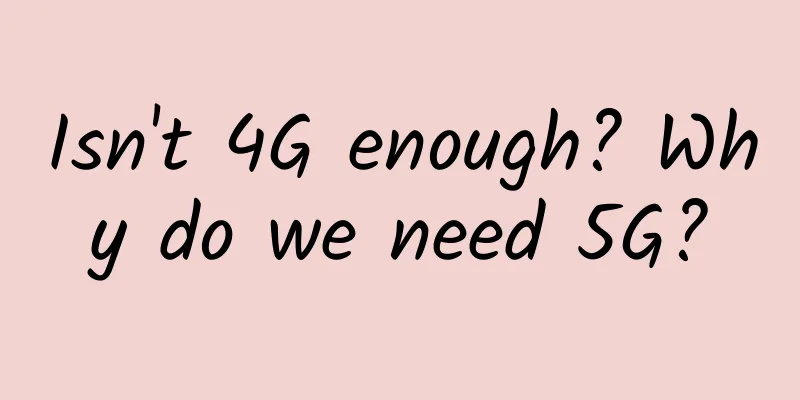Isn't 4G enough? Why do we need 5G?

|
Since the Swedish operator TeliaSonera officially launched the world's first LTE network in 2009, 4G has been a hot technology that has attracted the attention of many operators and media. While the 4G construction of the three major domestic operators is in full swing, 5G has once again entered everyone's sight. Whether it is operators such as China Mobile and Vodafone or equipment manufacturers such as Huawei and ZTE, the desire for 5G has long been revealed. Various media have even described 5G in a exaggerated way, as if in the 5G era, we can enjoy an unprecedented Internet experience. But is this really the case? What are the unknown secrets behind 5G? 1. Does 5G solve the problem of watching videos on the move? There is a view that 5G can only solve one problem, which is watching videos on the move. Other benefits such as global roaming brought by a single standard and simplified terminal design will not be realized because the global frequency band is no longer unified and programmable filters cannot be implemented. Unfortunately, this view is not correct. Because each generation of mobile communication technology focuses on different things, different technologies are essentially different. In the 1G and 2G eras, technical researchers focused on people's most basic need, "voice". In the 3G and 4G eras, due to the rapid development of the Internet, especially mobile Internet, people's demand for Internet access anytime, anywhere has become increasingly strong. The biggest feature of 3G and 4G is that they can provide extremely high wireless transmission rates. The 100Mbps, 150Mbps, etc. commonly seen in advertisements are their selling points. With the popularity of smartphones, watching videos anytime, anywhere through 4G networks has long become a reality. As an upgrade of 4G, it is even easier to watch videos anytime, anywhere with 5G. If you only regard 5G as a high-speed mobile network, you are totally wrong. A true 5G terminal is not only compatible with the 4G standard, but also can reduce the terminal cost and provide true global roaming. With the popularization of 4G, especially the promotion of VoLTE, the future 4G network will replace the 2G and 3G networks and become the mainstream of global operators. By 2020, when 5G is commercially available, 2G and 3G networks will be withdrawn from the network worldwide, and the global communication standard will be mainly 4G. At this stage, the full-standard fusion chip has already technically solved the problem of multi-standard and multi-frequency global roaming (such as iPhone6). If 2G and 3G are withdrawn from the network, the mobile terminal design only needs to support 4G and 5G networks. This kind of mobile phone is not only low-cost, but also easier to roam globally. It can be said that the 5G era not only solves the problem of watching videos on the move, but also completely solves the problem of global roaming. 2. Does 5G mean an improvement in spectrum utilization? There is also a view that as new-generation communication technologies replace previous-generation communication technologies, spectrum utilization efficiency will become increasingly higher. For this reason, all 5G needs to do is to improve the spectrum utilization of 4G. Unfortunately, the situation is not that simple. Long before the issuance of 4G licenses, China Unicom launched a WCDMA network with a peak rate of 42Mbps in many cities. Due to the use of a variety of advanced modulation technologies, the upgraded version of WCDMA can achieve a peak rate of 42Mbps using only a 5MHz bandwidth. In the 4G era, even FDD-LTE, which has the fastest peak rate, can only achieve a peak rate of up to 150Mbps under a bandwidth of 20MHz. In other words, the peak rate of FDD-LTE with a bandwidth of 5MHz is only 37.5Mbps, and the spectrum utilization rate is even lower than that of 3G networks. This is the case with FDD-LTE, not to mention TD-LTE. It can be said that if we only look at the spectrum utilization rate, the 4G network does not have much advantage over the 3G network, and the improvement of spectrum utilization rate has encountered a bottleneck. Due to the scarcity of spectrum resources, in order to achieve high speed in wireless communication, in addition to improving spectrum utilization through modulation technology, the remaining way is to increase the transmission bandwidth. A common example is WiFi. From the early 802.11a/b/g/n to the later 802.11ac, the transmission rate has been continuously improved. The trick is dual frequency. In the early WiFi standards, the 2.4GHz frequency band is often used. Due to the large number of users, this channel often has strong interference, which directly affects the actual user experience. In order to solve this problem, the WiFi Alliance adopted a new frequency band of 5.8GHz. Although this channel has a higher frequency, it has less interference. By combining the two frequency bands, the latest WiFi standard can easily achieve a download rate of more than 150Mbps. Taking Wi-Fi as a reference, after spectrum utilization reached a bottleneck, multi-frequency hybrid networking became a consideration for 5G. By superimposing the rates of different frequency bands, 5G can fundamentally solve the problem of limited network rate. Although spectrum utilization cannot be improved for the time being, 5G can still achieve high rates that 4G cannot achieve. 3. Can everyone enjoy high speeds in the 5G era? Similar to Wi-Fi, whether it is 4G or 5G, wireless network resources are shared by multiple people. If only one user accesses the base station, theoretically, he can enjoy the peak rate. But if 10 users access the base station to download data at the same time, ignoring other interference factors, each user can only enjoy a maximum of one-tenth of the download rate. Of course, the actual situation may be more complicated, and the download rate may be affected by many factors such as signal strength, the number of users downloading data at the same time, the number of base station sectors, and the speed of the server. In real life, it is obviously impossible for a base station to provide services to only one user. Even the ultra-high speed advertised by 5G will not be too high when shared among multiple people (think about the feeling of being hacked). In fact, the high speed advertised by 5G does not have much effect on ordinary users. To experience a higher speed and lower cost network, the most direct way is to use wired optical fiber and use WiFi at the end to provide a small range of high-speed coverage. Expecting everyone to experience high speed through 5G is not only unacceptable in terms of cost, but the experience will also be greatly reduced as the number of users increases. Summarize The reason why 5G is coming is not because consumers have such and such demands, but because of the huge profits behind 5G. In order to get a share of the future communications market, operators and equipment manufacturers are racking their brains. Especially for China Telecom and China Unicom, the two brothers in distress, who are fed up with the many restrictions in the 4G era to support independent intellectual property rights, they are eager to have a technology that can fundamentally unify the 5G standards. Under the background of the country's support for independent intellectual property rights, we urgently hope that Chinese technicians can participate in the formulation of a complete 5G standard as soon as possible and gain as many advantages as possible in international cooperation. By that time, whether it is FDD or TDD, we can proudly say: "This is all the wisdom of the Chinese people"! As a winner of Toutiao's Qingyun Plan and Baijiahao's Bai+ Plan, the 2019 Baidu Digital Author of the Year, the Baijiahao's Most Popular Author in the Technology Field, the 2019 Sogou Technology and Culture Author, and the 2021 Baijiahao Quarterly Influential Creator, he has won many awards, including the 2013 Sohu Best Industry Media Person, the 2015 China New Media Entrepreneurship Competition Beijing Third Place, the 2015 Guangmang Experience Award, the 2015 China New Media Entrepreneurship Competition Finals Third Place, and the 2018 Baidu Dynamic Annual Powerful Celebrity. |
Recommend
This "brain killer" is difficult to cure!
I am a neurosurgeon. Ordinary people sometimes co...
Going out to pick wild vegetables? Don't pick this, it's highly poisonous!
In the season of rebirth, I heard that everyone w...
Four channels for APP to recall users: EDM, Push, SMS, and public account
The author of this article will share with you ho...
China Automobile Dealers Association: China Automobile Consumer Reputation Index in December 2021
On January 6, 2022, the China Automobile After-sa...
Why did he almost lose his life just because he was cutting his nose hair?
Many people like to trim their nose hairs, becaus...
We’ve thought of all the copywriting for brands leveraging the Dragon Boat Festival for you!
June is really a month that makes operations copy...
The competition for user time has entered the second half. Konka Group has created new opportunities for the living room economy with "shaking screen"
The battle between large-screen TVs and mobile ph...
How to operate and promote Weibo? 5 tips for Weibo operation and promotion!
Weibo's business model is already quite matur...
The hallucinogenic effect is comparable to that of an Apple headset? Beijing also has these "deadly" fungi
It is the peak season for wild mushrooms. It is n...
Analysis of marketing promotion hot spots in September!
September is the start of the school year, and th...
Ningde SEO Training: What are the conditions for doing SEO well? Do you know them all?
In the process of SEO optimization , many SEO sta...
This article will show you the magical ocean temperature difference power generation
The ocean is the world's largest solar collec...
Pepper: a “cultural and military” species
A former luxury spice While preparing dinner, you...
Holding back tears increases the risk of 3 diseases! Tears also have these unexpected benefits
"It's not a sin for men to cry." Wh...
Practical Collection | "Luckin Coffee" New Retail Hot-selling Growth Methodology
Like the spring thunder that scares away hundreds...









